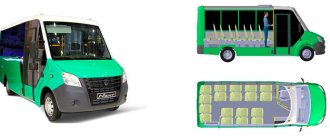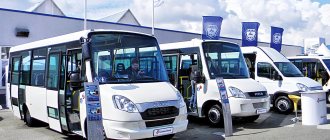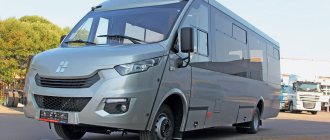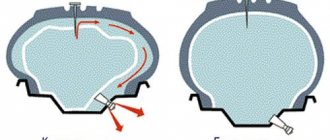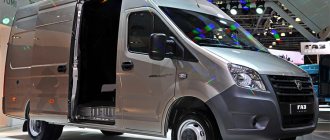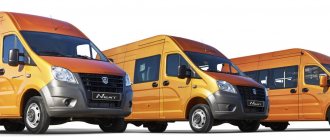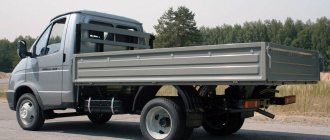Sergey Ukhov Photos of the author and manufacturer
At the dawn of the appearance at the Gorky, and then still Nizhny Novgorod, automobile plant, they did not hesitate with the designations of the cars coming out of its workshops: a flatbed truck, a passenger car, and then a bus would have been called NAZ-1, NAZ-2 and NAZ-3, if not for the order “ from above" about the borrowing of American designations. After 80 years, GAZ is again resorting to simplifying model names, adding the word Next to their usual name (that is, next).
The popularity of the most popular minibus in the Russian automobile industry, the GAZelle, has been declining in recent years. And there are several reasons for this: obsolescence of the design, less than exemplary reliability, efficiency and service life. And then there are competitors with their lucrative offers of much more modern minibuses...
The plant, whose performance today depends solely on the success of the GAZelle family of light commercial vehicles, could not help but respond to the drop in demand. GAZ created a new generation car, trying to get rid of the shortcomings of the previous design as much as possible. Serial production of the base vehicle of the next generation, called GAZelle Next, started in April 2013. But even such a large industrial holding as the GAZ Group cannot afford a one-time large financial and technological injection in order to suddenly switch to producing a new generation of cars. In addition, by gradually introducing new Next models and modifications to the market, in parallel with the popular models of the previous Business generation, the plant insures itself against possible rejection of the new product. The same is true with the transition to original, more modern components and assemblies, the introduction of which is carried out gradually. All this gives the company time to accumulate the necessary funds and competencies to create new models and units, developers to work out the design more thoughtfully, and testers to get rid of the so-called “childhood diseases” that accompany all new developments. The consumer also receives a certain benefit by switching to a well-known, but more modern and convenient car, rather than to a completely unfamiliar product.
BORROW
Of course, the new bus borrowed not only the cabin from Next. The unification with Gazelle-Next is broad. First of all, this concerns the power unit. The powerful Cummins supercharged diesel engine is good not only for its reliability and durability (mileage before the first serious diagnosis is 750,000 km), but also for its efficiency. When fully loaded, the minibus consumes, as testers told me, no more than 15 liters of diesel fuel per 100 km.
The gearbox is also from a semi-truck, but with an intermediate shaft support, thanks to which it is capable of transmitting more torque, although it has the same dimensions.
The front suspension is exactly the same as that of Next - independent, with powerful arms and ball joints. Spring-loaded, assembled on a subframe onto which the steering rack is attached. With such a scheme, the ride and handling should be decent. The rear axle of the Next minibus is different from that of a truck - made of stronger steel. After all, increased loads await him: minibuses almost never have idle runs.
Another competitive advantage is the forced (electrically driven) differential locking of the rear axle “ELocker” made by the American manufacturer (Eaton). An extremely useful thing for winter roads! You can see how it works in the “augmented reality” for this material. Just point your smartphone at the icon and the video will appear on the screen.
Layout features
The bus body is made of two doors not only to comply with legal requirements for the safety of passenger vehicles, but also for convenience and speeding up the boarding/disembarking of passengers. The height of the first step of the front door is less than 40 centimeters. Behind - about 50.
Access to the driver's seat is through the front passenger door, and the driver's space is separated from the passenger compartment only by a low handrail with a plastic partition. The front panel completely replicates that of the GAZelle Next truck, but the space to the left of the driver and above him is completely original. The side panel, which replaces the driver's door, is equipped with a large storage pocket, a button for turning on the interior lighting and a microphone connector. There are three loudspeakers embedded in the ceiling panel above the driver. A traditional “bus” sunshade is installed at the top of the glass. The solution is correct, but not universal, since with a gigantic glass area in the cabin, the sun will blind the driver not only in front, but also on the right and left, where protective devices are not provided. The window in the side window is also made like a bus, sliding with the help of a corresponding handle.
In full compliance with the passenger capacity declared by the manufacturer (18 seats + 1 standing place), in practice the car is quite suitable for delivering a larger number of standing passengers. This is facilitated by the more than 1.9-meter height of the cabin, as well as handrails located on the ceiling and seats. Most likely, the total mass of seated and standing passengers will exceed the permitted load capacity, but, as we are no longer used to working with overload. That's why they have a reinforced spring suspension and frame, which competitors' cars have long been deprived of.
In terms of ease of movement in the cabin, the new Next frame bus is significantly superior to any modification of the “Business” generation bus. The internal space of the increased dimensions compared to the all-metal body made it possible to place 4 seats in width in the cabin, while leaving space for passage. And due to the fact that the walls of the frame bus body are absolutely vertical and do not taper towards the top, as in all-metal vans, nothing puts pressure on the shoulders of the outer passengers. Comfortable.
The creators of the car assure that the presence of two cabin heaters will ensure a comfortable temperature in the cabin even in severe frost, and athermal glass will protect passengers from the bright sun.
Technical characteristics of the GAZelle Next bus
| Modification | А64R42 | A63R42 |
| Purpose | Urban | Suburban |
| Passenger capacity | 19 | 18 |
| Number of seats | 18 | 18 |
| Total weight, kg | 4252 | 4292 |
| Base, mm | 3745 | |
| Overall dimensions, mm | 6080x2530x2720 | |
| Minimum ground clearance at full weight, mm | 170 | |
| Minimum turning radius, m | 6,6 | |
| Fuel consumption, l/100 km | 11,5 | |
| Maximum speed, km/h | 110 | |
| Engine | Cummins ISF2.8e4R129 | |
| Type | Diesel, with turbocharging and charge air cooler | |
| Cylinder displacement, l | 2,8 | |
| Rated power, net, kW (hp) | 88,7 (120.6) | |
| Front suspension | Independent, double wishbone with coil springs, with anti-roll bar | |
| Rear suspension | Longitudinal semi-elliptical springs with lower springs and anti-roll bar | |
| Steering | Rack and pinion type, with hydraulic booster, with adjustable steering column | |
| Body | Frame type made of steel pipes, with installed steel and plastic panels, with circular glazing | |
| Doors | The front one is service, rotary type with an electromechanical drive. Rear – spare, hinged with mechanical drive | |
| Guarantee | 24 months or 100,000 km | |
HURRY TO THE STOP
The designers took no less care of the driver than the passengers. Excellent visibility: panoramic windshield, low lower edge of the side glazing, huge exterior mirrors, high seating position. You can navigate and maneuver even near metro stations without stress. The seat has a lot of settings, the steering wheel is height adjustable.
On the move, the bus is surprisingly playful. The dynamics are not inferior to other passenger cars, and therefore on the Third Transport Ring of the capital, where Next was tested, I did not feel like a burden for fellow motorists. On the contrary, thanks to good acceleration and tenacious brakes (with anti-lock braking system), the ragged Moscow pace was easy for me.
The final test was carried out as a passenger, sitting in the back row. I asked my colleague not to let off the gas when passing speed bumps.
The soft suspension, specially tuned for the bus, identified an obstacle, but this did not affect comfort. I believe it will be even softer with a loaded interior.
Since the launch of bus production, it has been working in three shifts! And this is against the backdrop of an economic recession. The demand for “nexts” is huge - it is spurred by the high expected service life of the machine, minimal operating costs, a wide service network and an attractive price. Carriers claim that on a busy route, the Next minibus will pay for itself in three months. But the car is only at the beginning of its journey. I wouldn’t be surprised if his route extends far abroad.
PLUS I always felt awkward standing in foreign-made minibuses - but here it’s much more comfortable
MINUS The automatic door button is located in the same row as the others and does not stand out. It should be bright and large!
Test of the Gazelle-Next bus: at the beginning of the route
Rebuilding production
The frame bus is not a conventional passenger version of an all-metal cargo van, but a completely original design created solely for the convenience and efficiency of passenger transportation. Consequently, the GAZelle Next bus is much more different from the semi-current bus of the same name than the passenger and cargo modifications of the previous generation GAZelle Business.
The frame bus not only has an original body and cabin, but also a reinforced chassis, as well as a redesigned component base. The passenger capacity increased to 19 seats entailed an increase in gross weight, heavier units and a general enlargement of the dimensions of the vehicle. In this regard, even the assembly of the “frame” does not take place on the main conveyor, but in the special equipment production workshop of the Gorky Automobile Plant.
The pre-assembly production stages have undergone a major update. So, in the case of GAZelle Next, new stamping and welding lines were put into operation at the car plant. And mastering the production of the Next frame bus required a major modernization of the special equipment production workshop of the Gorky Automobile Plant: new laser cutting lines, automated pipe bending equipment were installed on the site, the painting complex was modernized, and new quality control points were introduced. The complex for high-precision welding of the body frame was developed and supplied by one of the leaders in production equipment engineering - LG.
